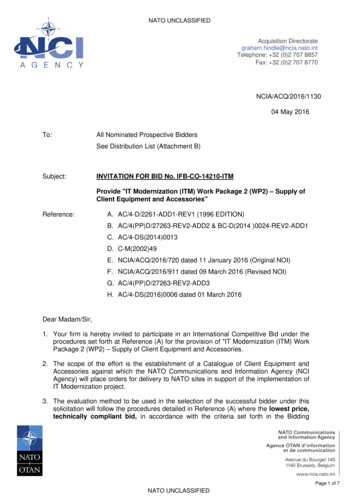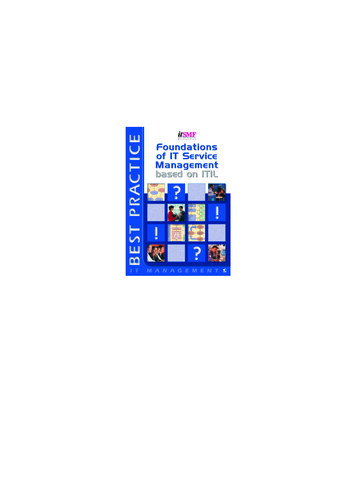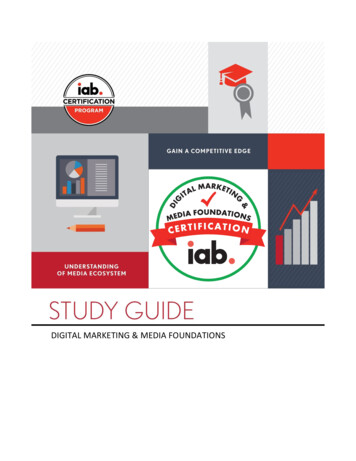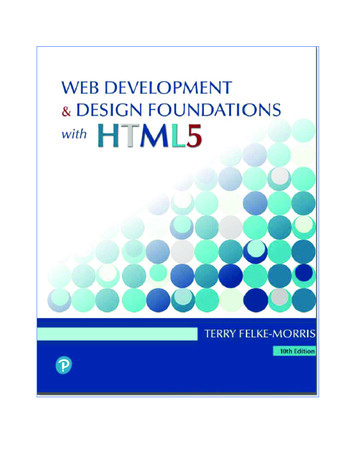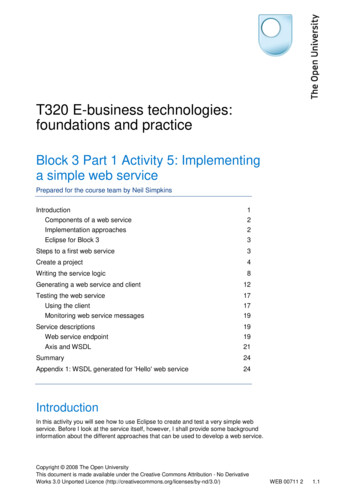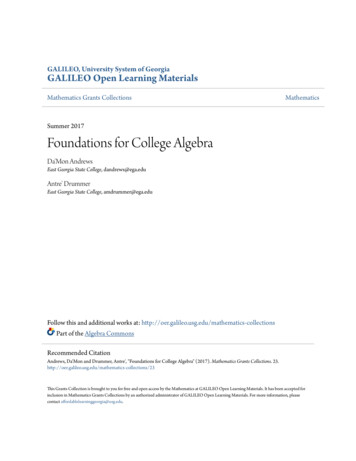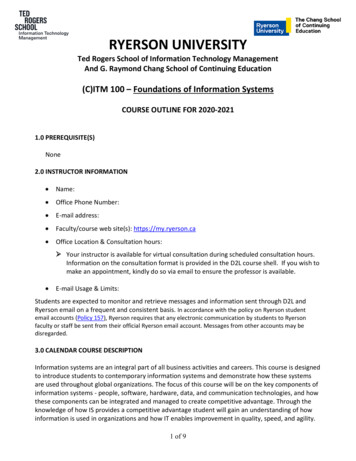
Transcription
RYERSON UNIVERSITYTed Rogers School of Information Technology ManagementAnd G. Raymond Chang School of Continuing Education(C)ITM 100 – Foundations of Information SystemsCOURSE OUTLINE FOR 2020-20211.0 PREREQUISITE(S)None2.0 INSTRUCTOR INFORMATION Name: Office Phone Number: E-mail address: Faculty/course web site(s): https://my.ryerson.ca Office Location & Consultation hours: Your instructor is available for virtual consultation during scheduled consultation hours.Information on the consultation format is provided in the D2L course shell. If you wish tomake an appointment, kindly do so via email to ensure the professor is available. E-mail Usage & Limits:Students are expected to monitor and retrieve messages and information sent through D2L andRyerson email on a frequent and consistent basis. In accordance with the policy on Ryerson studentemail accounts (Policy 157), Ryerson requires that any electronic communication by students to Ryersonfaculty or staff be sent from their official Ryerson email account. Messages from other accounts may bedisregarded.3.0 CALENDAR COURSE DESCRIPTIONInformation systems are an integral part of all business activities and careers. This course is designedto introduce students to contemporary information systems and demonstrate how these systemsare used throughout global organizations. The focus of this course will be on the key components ofinformation systems - people, software, hardware, data, and communication technologies, and howthese components can be integrated and managed to create competitive advantage. Through theknowledge of how IS provides a competitive advantage student will gain an understanding of howinformation is used in organizations and how IT enables improvement in quality, speed, and agility.1 of 9
This course also provides an introduction to systems and development concepts, technologyacquisition, and various types of application software that have become prevalent or are emergingin modern organizations and society.4.0 COURSE OBJECTIVES AND LEARNING OUTCOMESLearning outcomes describe what students are expected to have learned or achieved; as a result,they usually describe what students will be capable of doing, or what evidence will be provided tosubstantiate learning.Information systems are an integral part of all business activities. This course is designed to introducestudents to contemporary information systems and demonstrate how these systems are usedthroughout global organizations. The focus will be on the key components of information systems people, processes, software, hardware, data, and communication technologies, and how thesecomponents can be integrated and managed to create competitive advantage. Students will gain anunderstanding of how information technology enables improvement in quality, speed, and agility. Thiscourse emphasizes active learning integrating on-line and hands-on elements to accomplish itslearning objectives.Learning Outcomes1. Understand why and how information systems are used today with the ability to distinguishcompetitive advantage versus competitive necessity. Understand the role of informationsystems in the globalization of economic and cultural activities with an awareness of newapplications and technologies that provide new forms of communication and collaboration.2. Explain the technology, people, and organizational components of information systems andhow they interact. Identify and understand the functions and inter-connections of majorcomponents of an information systems infrastructure such as hardware, software, networks,and database systems.3. Understand how enterprise systems strengthen relationships between customers (throughCRM systems) and suppliers (through SCM systems) and how these systems are used toenforce organizational structures and processes. Comprehend the role of Enterprise ResourcePlanning (ERP) systems, which integrate internal and external management of informationacross an entire organization.4. Understand how to secure information systems resources, focusing on both human andtechnological safeguards. Be able to identify potential threats to information systems andunderstand methods that reduce risks as well as plan for, and recover from, disasters.5. Understand how an information system can provide the information needed to build businessintelligence that supports decision making within different levels and functions of theorganization.6. Evaluate the ethical concerns that information systems raise in society and the impact ofinformation systems on crime, terrorism, and war.7. Apply analytical and problem-solving skills to business problems using spreadsheet software.2 of 9
5.0 TEXTS & OTHER READING MATERIALSLectureTitle: Management Information Systems: Managing the Digital Firm, (16th Edition)Author(s): Kenneth C. Laudon, Jane P. LaudonPublisher: PearsonISBN: 978-0135191927LabTitle: Skills for Success with Microsoft Excel 2016 ComprehensiveAuthor(s): Margo Chaney, Lisa Hawkins, Shelley GaskinPublisher: PearsonISBN: 978-01344795076.0 TEACHING METHODSIn Fall 2020 this course will be taught will be taught remotely in virtual classrooms. Instruction willtake place at scheduled hours, following the approach outlined in D2L Brightspace. You will not berequired to attend the Ryerson University campus to complete this course.7.0 EVALUATION, ASSESSMENT AND FEEDBACKThe grade for this course is composed of the mark received for each of the following components:Evaluation ComponentCase AssignmentsExcel LabsGroup WorkParticipationFinal ExamTotalPercentage of the Final Grade20%30%20%10%20%100%NOTE: Students must achieve a course grade of at least 50% to pass this course. At least 20% of student’s grade based on individual work will be returned to students prior to thelast date to drop a course in good academic standing .Citation Format for Essays and Term PapersAll essay assignments, term paper and other written works must adhere with APA citation format.3 of 9
Technical errors (spelling, punctuation, proofing, grammar, format, and citations) and/orinappropriate levels of language or composition will result in marks being deducted. You areencouraged to obtain assistance from the Writing Centre (www.ryerson.ca/writingcentre) for helpwith your written communications as needed.You can find APA guidelines and academic referencing from the following online resources:Student Learning Support Online Resources Writing Support Resources APA Basic Style GuideRyerson Library Citations and Style Guides APA Style8.0 PLAGIARISM DETECTION(Please delete the following two (2) points if NOT relevant for your course)TurnitinTurnitin.com is a plagiarism prevention and detection service to which Ryerson subscribes. It is atool to assist instructors in determining the similarity between students’ work and the work ofother students who have submitted papers to the site (at any university), internet sources, and awide range of books, journals and other publications. While it does not contain all possiblesources, it gives instructors some assurance that students’ work is their own. No decisions aremade by the service; it generates an “originality report,” which instructors must evaluate tojudge if something is plagiarized.Students agree by taking this course that their written work will be subject to submission fortextual similarity review to Turnitin.com. Instructors can opt to have student’s papers includedin the Turnitin.com database or not. Use of the Turnitin.com service is subject to the terms-ofuse agreement posted on the Turnitin.com website. Students who do not want their worksubmitted to this plagiarism detection service must, by the end of the second week of class,consult with their instructor to make alternate arrangements.Even when an instructor has not indicated that a plagiarism detection service will be used, orwhen a student has opted out of the plagiarism detection service, if the instructor has reason tosuspect that an individual piece of work has been plagiarized, the instructor is permitted tosubmit that work in a non-identifying way to any plagiarism detection service.Virtual Proctoring (if used in this course)Online exam(s) within this course use a virtual proctoring system. Please note that yourcompletion of the exam will be recorded via the virtual platform and subsequently reviewed byyour instructor. The virtual proctoring system provides the instructor with a recording that onlyincludes video where possible indications of suspicious behaviour are identified. Recordings willbe held for a limited period of time in order to ensure academic integrity is maintained.4 of 9
Access to a computer that can support remote recording is your responsibility as a student. Thecomputer should have the latest operating system, at a minimum Windows (10, 8, 7) or Mac (OSX 10.10 or higher) and web browser Google Chrome or Mozilla Firefox. You will need to ensurethat you can complete the exam using a reliable computer with a webcam and microphoneavailable, as well as a high-speed internet connection. Please note that you will be required toshow your Ryerson OneCard prior to beginning to write the exam. In cases where you do nothave a Ryerson OneCard, government issued ID is permitted.Information will be provided prior to the exam date by your instructor who may provide anopportunity to test your set-up or provide additional information about online proctoring. Sincevideos of you and your environment will be recorded while writing the exam, please considerpreparing the background (room / walls) so that personal details are not visible, or move to aroom that you are comfortable showing on camera.9.0 TOPICS – SEQUENCE & SCHEDULESessionTopicLearning Outcomes 1Information Systems inBusiness Today 2How Businesses UseInformation Define an information systemand explain how it worksExplainhowinformationsystems are transformingbusiness, and why they areessential for running a businesstodayExplain academic disciplinesthat study information systemsand how each contributes to anunderstanding of informationsystemsDescribe business processesand how they are related toinformation systemsExplain how systems serve thedifferent management groupsin a businessDescribe the importance ofsystems for collaboration andsocial businessesDescribe the role of theinformation systems functionin a business5 of 9Reading(s)Activities & DueDatesLaudon &Laudon:Chapter 1Case 1Laudon &Laudon:Chapter 2Case 2
3IT Infrastructure 4 Databases andInformationManagement 6Enhancing DecisionMaking 7Laudon &Laudon:Chapter 5Case 3Laudon &Laudon:Chapter 6Case 4Laudon &Laudon:Chapter 12Case 5Laudon &Laudon:Chapter 7Case 6Case Discussion 1 5Describe IT infrastructure, andthe stages and drivers of ITinfrastructure evolutionDescribe the components of ITinfrastructureExplain the challenges ofmanaging IT infrastructure andmanagement solutionsTelecommunications, theInternet, and WirelessTechnology Explain the major capabilities ofdatabase management systems(DBMS)Describe the principal tools andtechnologies for accessinginformation from databases toimprove business performanceand decision makingUnderstand why informationpolicy, data administration,and data quality assurance areessential for managing thefirm’s data resourcesDescribe the different types ofdecisions, and how the decisionmaking process workUnderstand how informationsystems support the activitiesof managers and managementdecision makingExplain how businessintelligence and businessanalytics support communications networksExplain the different types ofnetworksExplain how the Internet andInternet technology work, andhowtheysupportcommunication and e-businessDescribe the principaltechnologies and standards for6 of 9
8E-commerce: DigitalMarkets and DigitalGoods 9 Securing InformationSystems 11Emerging Technologies 12Laudon &Laudon:Chapter 10Case 7Laudon &Laudon:Chapter 8Case 8Laudon &Laudon:Chapter 5& Chapter 11Case 9Case Discussion 2 10wireless networking andInternet accessDescribe the unique features ofe-commerce, digital markets,and digital goodsExplain the principal ecommercebusinessandrevenue modelsUnderstand how e-commercetransformed marketingIdentify the role of mcommerce in business, and themost important m-commerceapplicationsEthical and Social Issuesin Information SystemsFinal Examination Understand why informationsystems are vulnerable todestruction, error, and abuseDescribe the business value ofsecurity and controlIdentify the components of anorganizational framework forsecurity and controlExplain the most importanttools and technologies forsafeguarding informationresourcesDescribe the current trends incomputer hardware platformsDescribe the current computersoftware platforms and trendsDescribe ethical, social, andpolitical issues raised byinformation systemsExplain specific principles forconduct that can be used toguide ethical decisionsUnderstand how informationsystems affected laws forestablishing accountability,liability, and the quality ofeveryday lifeFinal Examination7 of 9Laudon &Laudon:Chapter 4All of the above
10.0 VARIATIONS WITHIN A COURSEAll sections of a course (Day and CE sections) will follow the same course outline and will use thesame course delivery methods, methods of evaluation, and grading schemes. Any deviations willbe posted on D2L Brightspace once approved by the course coordinator.11.0 OTHER COURSE, DEPARTMENTAL, AND UNIVERSITY POLICIESFor more information regarding course management and departmental policies, please consult theCourse Outline Appendix which is posted on the Ted Rogers School of Information TechnologyManagement website.NOTE: Students must adhere to all relevant university policies found in their online course shell inD2L and /or on the following URL: senate-course-outline-policies.The appendix covers the following topics:Attendance & Class ParticipationEmail AccountRequest for Academic ConsiderationExaminations & TestsLate AssignmentsStandard of Written WorkAcademic Grading PolicyAcademic IntegrityStudent RightsImportant Resources Available at Ryerson Academic Accommodation Support: Ryerson University acknowledges that students havediverse learning styles and a variety of academic needs. If you have a diagnosed disabilitythat impacts your academic experience, connect with Academic Accommodation Support(AAS). Visit the AAS website or contact aasadmin@ryerson.ca for more information. Note: Allcommunication with AAS is voluntary and confidential, and will not appear on yourtranscript.8 of 9
The Library provides research workshops and individual assistance. If the University is open,there is a Research Help desk on the second floor of the library, or go to Workshops. Student Learning Support offers group-based and individual help with writing, math, studyskills, and transition support, as well as resources and checklists to support students as onlinelearners. You can submit an Academic Consideration Request when an extenuating circumstance hasoccurred that has significantly impacted your ability to fulfill an academic requirement. Ryerson COVID-19 Information and Updates for Students summarizes the variety ofresources available to students during the pandemic. Familiarize yourself with the tools you will need to use for remote learning. The Continuity ofLearning Guide for students includes guides to completing quizzes or exams in D2L orRespondus, using D2L Brightspace, joining online meetings or lectures, and collaborating withthe Google Suite.9 of 9
Ted Rogers School of Information Technology Management . And G. Raymond Chang School of Continuing Education (C)ITM 100 – Foundations of Information Systems . COURSE OUTLINE FOR 2020-2021 . 1.0 PREREQUISITE(S) None . 2.0 INSTRUCTOR INFORMATION
